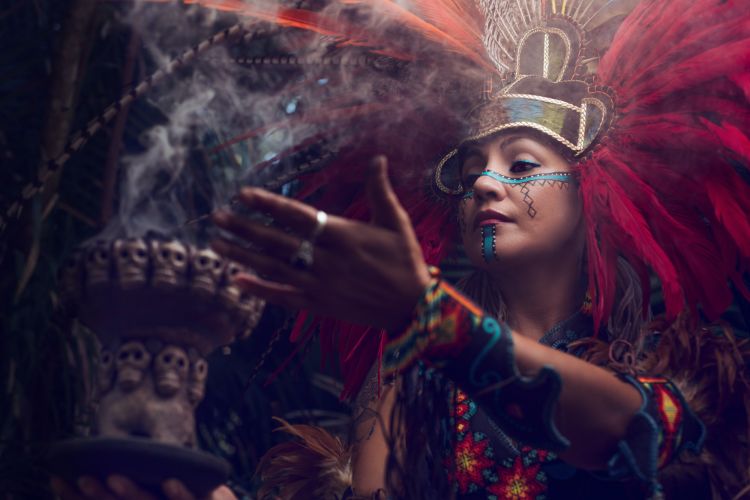
A little over a year ago, JP Stones started a stunning visual project photographing Ancient Aztec culture in Mexico. The idea was to recreate Aztec myths using the power of photography with rich and vibrant images for the younger generation of Mexicans who are mostly exposed to western culture. It was only this weekend that I caught wind of his work and at first thought it was an ad for an upcoming film. Diving in, I found it there was so much more to this cinematic series and JP as a creative.
JP Stones is a Cultural Photographer whose passion has taken him all over the world, and disproportionately, often to Mexico. This is probably because, with over 60 different ethnic groups, Mexico is one of the most diverse countries in the world and gives him an incredibly varied playground to work with.
“I took this on a workshop while demonstrate the composition we were aiming for. It’s a softbox with strobe camera right. Set above eye level and slightly behind model to give a dark side rembrandt light. There is an OCT gel on a bare bulb speedlight behind the model accentuating the sun (which was coming in and out). That is what is catching the orange feathers. The fill light bare bulb speedlight camera left bouncing off a reflector.”
It was while living in the Mexican state of Nayarit that JP became close with one of these groups: the Mexica, or Azteca. “We were discussing how little popular culture is devoted to Mesoamerican stories: it’s Apocalypto and not much else,” says JP, “so we thought this was an opportunity to recount some of these ancient tales through photography.” As a result, this project is a cinematic, almost heroic take on the creation myths behind modern-day Mexico. Included in the collection of myths is the haunting story of Popocatépetl and Iztaccíhuatl, Mexico’s Romeo and Juliette.

JP teamed up with an indigenous Azteca community to Share Their History.
To create these portraits, JP and his team hiked into the jungle packing strobes, fans, and smoke machines, as well as other insanely heavy props. JP notes, “We’re trying to recreate these fantastical, otherworldly tales – without using Photoshop – so the pyrotechnics help set the mood. I hope that when we get that right, the photos will resonate with people, and get them interested in Mexico’s rich cultural history.”

Location scouting is a big part of the process as the natural world plays a formative role in indigenous cultures. So while many portrait photographers work in a studio where they can control their environment, JP and crew braved the wind, waves, and sunburn to show that connection between model and nature. Sometimes, it requires a stunning landscape, but other times a few ferns will do the trick.
Each potential location has to pass a few tests:
- Is it visually suitable for the concept?
- What times of day will the light work?
- Is it accessible for models and all equipment?
- Is it in an area I need permission to shoot in?
What Was Used For The Images?
Gear wise I used a 400w Smoke Machine (any from amazon) that my strobe battery (Paul C Buff) can power. My assistant Dan is camera right doing a little dance with it to get an even spread of smoke. He’s become a ninja with the smoke machine as we use smoke all the time. It gives us atmosphere at the press of a button. I have three smoke machines and I have been known to use all three in one photo.
Because of where the tree was, we had to set up in the river itself so there is a 43’’ Westcott octabox (camera left) with a Canon 430II speedlite in the river. I burn through equipment quickly…
I’m also using a smaller diffuser (camera right) with a Canon 430II speedlite for fill the model a bit (feathered light) and to catch the smoke.Many of these photos have a story behind the. We don’t just take portraits of the models. They are friends of mine, and we chat about their history and the myths that make their culture so unique. Then try and create epic photos that capture all those elements. As you’ve seen that means carrying strobes, speedlights, smoke machines and fans to some out there placed to recreate an ancient myth.
More Images From The Series
About The Project & JP
The cultural workshop project is run by JP Stones, a British-born, Mexico-based photographer. JP’s work has been published in several photography publications, including two recent cover features for Good Light Magazine.
The workshops have as their primary goal to bring together photographers with Mexico’s fascinating culture.

Models in this series include the following: Tekuan, Metstli, Linda M, Adrianne S, & Tekie Nierykaia.
To view more of this series and JP’s work, visit his websites and social media accounts (listed below):
- Website: www.jpstonesphotography.com
- Instagram: www.instagram.com/jpstones
- Facebook: www.facebook.com/jp.stones.photography
What do you think about this project? Does it serve as an effective medium to shine a light on a relatively unknown piece of history? Do you know of any other interesting cultural projects you’d like to share? Let us know in the comments below.
*All images shared with permission from JP Stones. Do not share or use the images without direct written permission from the copyright holder.












Get Connected!